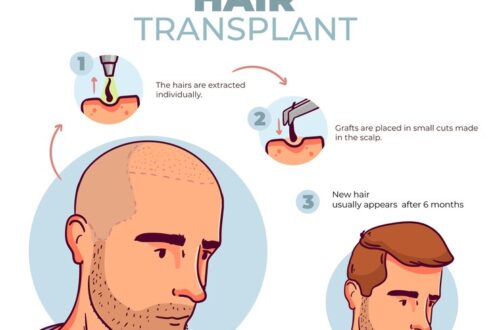Hair loss affects millions of people around the world. It can be particularly challenging to deal with its emotional and psychological impacts. Hair transplant surgery offers a reliable solution to this problem by permanently restoring hair. But what exactly is hair transplant surgery, and how does it work?

Understanding Hair Transplant Surgery
Hair transplant surgery involves transferring hair follicles from a part of the body where hair is plentiful to the balding or thinning area. This surgical procedure is minimally invasive and is performed under local anesthesia. Making it a safe and effective solution for hair loss. It is a permanent solution for hair loss, offering natural-looking results. This advanced technique helps restore hair and confidence for individuals experiencing hair thinning or balding.
Why Choose Dr. Thakurs Nexgen Hair Clinic?
Choosing the right clinic for hair transplant surgery is crucial. Dr. Thakurs Nexgen Hair Clinic in Nashik stands out for several reasons:
- Expertise: Dr. Thakur has extensive experience and training in hair restoration techniques.
- Technology: The clinic uses state-of-the-art equipment and the latest methods to ensure the best results.
- Patient Care: From initial consultation to post-surgery follow-ups, the clinic offers comprehensive care and support.
Types of Hair Transplant Procedures
There are two primary types of hair transplant procedures:
Follicular Unit Transplantation (FUT)
In FUT, a strip of skin with hair follicles is removed from the donor site. The follicles are then extracted and transplanted to the recipient site. This method is ideal for covering large balding areas and can provide a natural-looking hairline.
Follicular Unit Extraction (FUE)
FUE involves extracting individual hair follicles directly from the donor site and implanting them into the recipient site. This method leaves minimal scarring and has a faster recovery time compared to FUT. It’s often preferred by those who want to avoid linear scars.
Platelet-Rich Plasma (PRP)
PRP hair transplant surgery combines platelet-rich plasma (PRP) therapy with traditional hair transplants. The medical team injects PRP, derived from the patient’s blood, into the scalp to stimulate hair growth and enhance healing. This innovative procedure promotes thicker, healthier hair and improves the success and recovery of hair transplant surgeries.
The Hair Transplant Process
The hair transplant process involves several steps, each crucial for achieving the best possible results:
- Consultation: The journey begins with the medical team conducting a detailed consultation to assess the patient’s hair loss pattern, medical history, and expectations.
- Planning: The medical team develops a personalized treatment plan that outlines the type of procedure. The number of grafts needed, and the expected outcomes.
- Surgery: The actual transplant procedure is performed with precision and care.
- Recovery: Post-surgery, patients receive detailed instructions to ensure proper healing and optimal results.
Preparation for Hair Transplant Surgery
Preparing for hair transplant surgery involves a few important steps:
- Medical Evaluation: A thorough medical evaluation ensures the patient is fit for surgery.
- Pre-Surgery Instructions: Patients are given specific instructions. Such as avoiding certain medications and refraining from smoking, to ensure the procedure goes smoothly.
The Day of Surgery: What to Expect
On the day of the surgery, patients can expect the following:
- Local Anesthesia: The recipient and donor areas are numbed to prevent any discomfort.
- Extraction and Implantation: The surgeon extracts hair follicles from the donor area and implants them into the balding area. Depending on the chosen method (FUT or FUE)
- Duration: The procedure typically lasts several hours, depending on the number of grafts.
Post-Surgery Care and Recovery
Post-surgery care is crucial for the success of the hair transplant:
- Immediate Care: Doctors advise patients to avoid strenuous activities and to sleep with their heads elevated.
- Follow-Up Visits: Regular follow-up visits ensure the healing process is on track.
- Long-Term Care: Doctors give patients guidelines on how to care for their new hair, including when to resume normal activities and how to wash the transplanted area.
Results and Expectations
Hair transplant results can vary, but most patients start seeing new hair growth within a few months. Full results are typically visible after 9 to 12 months. It’s important to have realistic expectations and understand that hair growth is a gradual process.
Patient Success Stories
Hearing about other patients’ experiences can be incredibly reassuring. At Dr. Thakurs Nexgen Hair Clinic, many patients have shared their success stories. Highlighting how the procedure has transformed their lives. From regaining confidence to enjoying a more youthful appearance. These stories reflect the positive impact of hair transplant surgery.
FAQs
Q1. Is hair transplant surgery painful?
A. Patients do not feel pain during the surgery because the procedure is performed under local anesthesia. Patients may experience some discomfort during recovery, but they can generally manage it with prescribed medications.
Q2. How long does the recovery process take?
A. Most patients can return to normal activities within a week. However, full recovery and the appearance of new hair growth can take several months.
Q3. Are the results of hair transplant surgery permanent?
A. Yes, the transplanted hair follicles are resistant to the hormones that cause hair loss, making the results permanent.
Q4. Can women undergo hair transplant surgery?
A. Absolutely. Women experiencing hair thinning or baldness can also benefit from hair transplant surgery.
Q5. How much does hair transplant surgery cost at Dr. Thakurs Nexgen Hair Clinic?
A. The cost varies depending on the extent of hair loss and the number of grafts required. It’s best to schedule a consultation to get an accurate estimate.
Conclusion
In conclusion, hair transplant surgery offers a reliable and effective solution for individuals struggling with hair loss. By utilizing advanced techniques and technology, this procedure provides natural-looking, long-lasting results, restoring not only hair but also confidence and self-esteem. Incorporating PRP therapy further enhances the success and healing process of hair transplants. Choosing hair transplant surgery can be a transformative decision, leading to an improved appearance and a renewed sense of self.





One comment on “Hair Transplant Surgery”